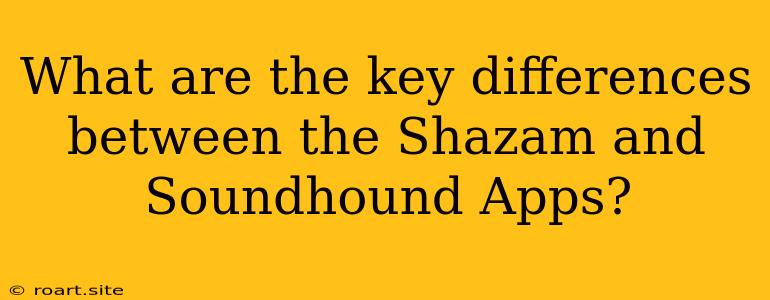In the realm of music identification apps, Shazam and SoundHound stand out as two popular choices. Both apps have a singular purpose: to identify songs playing in your environment. But despite their shared goal, they possess distinct features and approaches that cater to different user preferences. This article delves into the key differences between Shazam and SoundHound, examining their strengths, weaknesses, and the specific scenarios where one might be a better choice than the other.
Shazam: The Recognizable Icon
Shazam is arguably the most recognizable music identification app globally. Its iconic blue and white logo has become synonymous with identifying songs. Its popularity stems from its simplicity and reliability. When you launch Shazam, you're greeted with a single button. A tap on this button activates the app's listening mode, which analyzes the sounds around you to pinpoint the song playing. Within seconds, Shazam will display the song title, artist, and album cover.
Strengths of Shazam:
- Ease of Use: Shazam's interface is remarkably straightforward. Its one-button operation makes it incredibly user-friendly, even for those unfamiliar with music identification apps.
- Accuracy: Shazam is known for its impressive accuracy in identifying songs, even amidst background noise.
- Extensive Music Library: Shazam boasts a vast database of songs, covering various genres and eras.
- Social Integration: Shazam allows you to share your discoveries with friends on social media platforms like Facebook, Twitter, and Instagram.
- Lyrics Support: The app displays song lyrics, allowing you to sing along or learn the words.
- Music Discovery: Shazam provides recommendations for similar artists and songs based on your listening history.
Weaknesses of Shazam:
- Limited Functionality: Compared to SoundHound, Shazam offers fewer additional features. While it has lyrics support, it lacks features like music playback or artist information.
- Basic User Interface: While simple, the user interface may seem a bit dated and could benefit from a more modern design.
SoundHound: Beyond Music Identification
SoundHound takes a more comprehensive approach to music identification, offering a wider range of features beyond simply recognizing songs.
Strengths of SoundHound:
- Lyrics Search: SoundHound allows you to search for songs using lyrics. You can even hum or sing a few lines, and the app will identify the song based on your vocalization.
- Music Playback: SoundHound enables you to listen to identified songs directly within the app, using its built-in music player.
- Artist Information: SoundHound provides in-depth information about artists, including their biographies, discography, and social media links.
- Live Lyrics: SoundHound displays animated lyrics that synchronize with the music, enhancing the listening experience.
- Music Recognition Modes: The app offers different listening modes, such as "Automatic Recognition," which constantly listens for music, and "Manual Recognition," which you can activate manually.
- Voice Control: SoundHound integrates voice control features, allowing you to control the app using voice commands.
Weaknesses of SoundHound:
- More Complex Interface: SoundHound's interface is more complex than Shazam's, with more options and features, which may initially feel overwhelming for some users.
- Slightly Less Accurate: While still reliable, SoundHound's music recognition accuracy may be slightly lower than Shazam's in certain situations, particularly in noisy environments.
Choosing the Right App for You:
Ultimately, the best app for you depends on your individual needs and preferences.
- For Simplicity and Speed: Shazam is the clear winner. Its intuitive interface and reliable music recognition make it ideal for quickly identifying songs.
- For Comprehensive Features and Music Exploration: SoundHound is the better choice. Its diverse features, including lyrics search, music playback, and in-depth artist information, offer a more immersive music experience.
Conclusion:
Both Shazam and SoundHound excel in identifying music. Shazam's simplicity and accuracy make it a go-to option for casual users. SoundHound, with its comprehensive features and focus on music exploration, appeals to users seeking a more engaging and feature-rich experience. No matter your preference, both apps are powerful tools for discovering, identifying, and enjoying music in the digital age.
